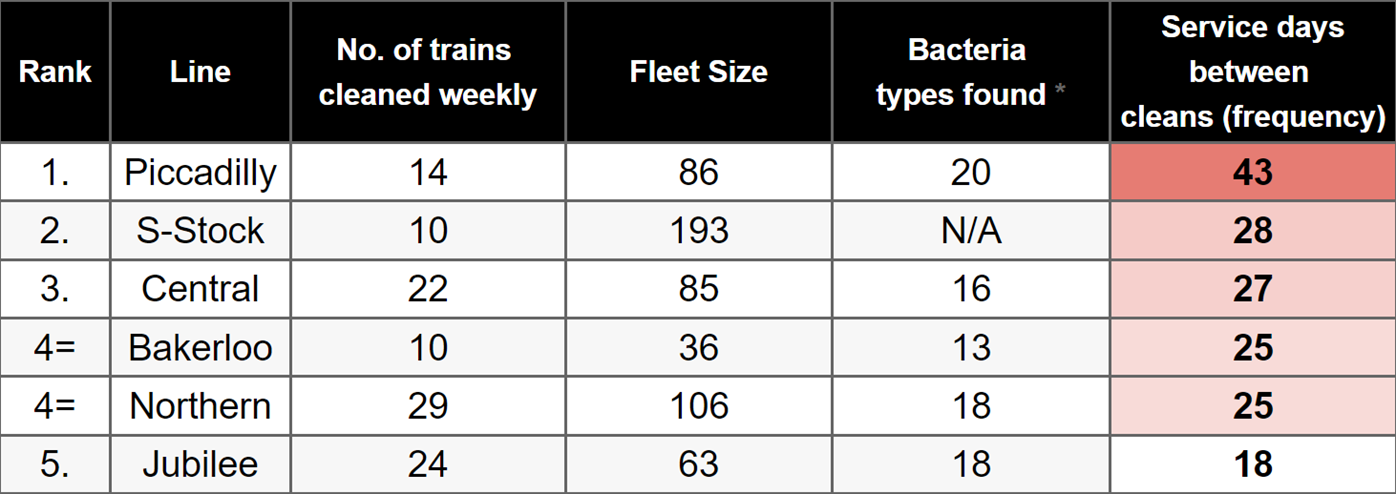Latest TfL figures show the London Underground reaching four million journeys per day, with last year’s August Bank Holiday ridership figures the highest since the pandemic. Amid reports that the Victoria line seats contain up to 16,000 colony-forming units of E. coli, shower enclosure specialists Showers to You submitted a Freedom of Information request to Transport for London (TfL) in a bid to uncover which Tube lines are cleaned least frequently and the importance of showering after travelling on public transport to prevent the spread of bacteria.
London Underground: the dirty truth about cleaning
The results: the least frequently cleaned London Underground lines:
Piccadilly is the least frequently cleaned line with 43 days between cleans
The Piccadilly line: the dirtiest of the dirty
Shower enclosure specialists Showers to You’s Freedom of Information request revealed that the Piccadilly line is the least frequently cleaned service on the London Underground. With a fleet of 86 trains, the Piccadilly line sees 14 trains cleaned each week, meaning that on average, each train will be cleaned approximately every 43 service days.
If operating daily, this results in almost a month and a half between cleans. Given this extended interval, it’s unsurprising that the Piccadilly line ranks among the highest for bacteria levels (20).
Ranking second is the London Underground’s S-Stock, with 28 service days between cleans. They’re the sub-surface trains that operate on the Metropolitan, District, Circle, Hammersmith and City lines. If the train is in service each day, this is equivalent to almost a month between cleans. Despite having the largest fleet size at 193 trains, just 10 trains are cleaned per week, meaning it can take close to four and a half months for all S-Stock trains to be cleaned.
Central line trains are in use for almost a month before cleans
Following closely in third place is the Central line, with 27 service days between cleans. The Central line is the busiest London Underground service with 260.9 million journeys, making it surprising that it’s the third-least frequently cleaned service. Despite having a similarly sized fleet to the Piccadilly line with 85 trains, almost double the number of trains are cleaned on the Central line per week (22) than on the Piccadilly line (14).
What is going on at TfL?
Despite their stark difference in fleet size, the Bakerloo and Northern lines are in joint fourth place, with 25 service days between cleans. The Bakerloo line has a fleet size of 36 trains, compared to the Northern line’s fleet of 106 trains. On the Bakerloo line, 10 trains are cleaned weekly whilst 29 trains are cleaned weekly on the Northern line.
Jubilee is the most frequently cleaned line with 18 days between cleans
The most frequently cleaned London Underground service is the Jubilee line, with 18 service days between cleans. Despite having a fleet size and bacterial levels comparable to those of the Piccadilly line, the number of service days between cleans on the Jubilee line (18) is almost half that of the Piccadilly line (43).
24 trains on the Jubilee line are cleaned each week, approaching the weekly cleaning rate of 29 trains on the Northern line. This is notable given that the Northern line operates a significantly larger fleet of 106 trains, compared to the 63 trains of the Jubilee line.
London Underground hygiene tips
Darren Smith, spokesperson at shower enclosure retailer Showers to You, shares their expertise on how to bathe effectively to avoid the spread of bacteria on the London Underground:
-
Thorough Hand Washing: “Wash your hands with soap and water for at least 20 seconds as soon as you arrive home. Pay special attention to areas like under the nails and between fingers to ensure all germs are removed”.
-
Shower Immediately: “Take a shower as soon as possible when returning home after using public transport. This helps remove any bacteria or grime that may have come into contact with your skin and clothing”.
-
Use Antibacterial Soap: “Use an antibacterial soap during your shower to help kill germs and bacteria that you may have picked up from surfaces on public transport”.
-
Clean Personal Items Regularly: “Make sure to clean personal items like your phone, bags, and clothing regularly. These items can harbour bacteria and transfer them to your body”.
-
Maintain Personal Hygiene: “In addition to regular showers, consider using antibacterial wipes for quick clean-ups when necessary. Keeping up with good personal hygiene practices can help minimise the risk of bacterial infections”.






















